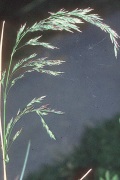Tussock Grasses and Meadow Grasses - Poa species

Poas include both native and introduced species. Most are perennial. Willis in "A Handbook to Plants in Victoria" included most of the Victorian native poas, and all of the native species dealt with here, in a broad Poa australis. It is not always easy to identify poas with certainty.
Poa spikelets are sideways compressed, with up to 12 bisexual florets. The spikelets are small, usually up to 5mm long. The upper florets often reduced in size. Lemmas often have cobwebby hairs at the base. Grey Tussock-grass (Poa sieberiana) is by far the most common native poa and is very abundant in forest areas. Common Tussock-grass (P. labillardierei) grows in wetter areas e.g. stream banks or wetter forests. Soft Tussock-grass is more common in grasslands.
 Annual Meadow-grass (*Poa annua) A soft grass with bright-green flat leaves. Low growing to 5 or 10cm high. Common garden weed in winter.
Annual Meadow-grass (*Poa annua) A soft grass with bright-green flat leaves. Low growing to 5 or 10cm high. Common garden weed in winter. Bulbous Meadow-grass (*Poa bulbosa) Open egg-shaped flower clusters on erect stems in Spring. Weedy places and forest verges. Bulbous at the base.
Bulbous Meadow-grass (*Poa bulbosa) Open egg-shaped flower clusters on erect stems in Spring. Weedy places and forest verges. Bulbous at the base. Kentucky Meadow-grass (*Poa pratensis) Common lawn grass, sometimes escaping. Leaves are flat and green.
Kentucky Meadow-grass (*Poa pratensis) Common lawn grass, sometimes escaping. Leaves are flat and green.  Grey Tussock-grass (Poa sieberiana) Very common in forests. Tussocks are generally small and wiry. Delicate flower clusters. Usually hairless, or with very short hairs.
Grey Tussock-grass (Poa sieberiana) Very common in forests. Tussocks are generally small and wiry. Delicate flower clusters. Usually hairless, or with very short hairs. Soft Tussock-grass (Poa morrisii) Like Grey Tussock-grass. Leaves are softly hairy with spreading hairs. Mostly in grasslands.
Soft Tussock-grass (Poa morrisii) Like Grey Tussock-grass. Leaves are softly hairy with spreading hairs. Mostly in grasslands. Common Tussock-grass (Poa labillardierei) Grows to a large tussock. Wetter areas e.g. stream flats, Mt Alexander.
Common Tussock-grass (Poa labillardierei) Grows to a large tussock. Wetter areas e.g. stream flats, Mt Alexander.  Rough Tussock-grass (*Poa trivialis) Wetter areas e.g. stream flats. Spikelets few-flowered. Cobwebby hairs copious at base of lemmas. Uncommon
Rough Tussock-grass (*Poa trivialis) Wetter areas e.g. stream flats. Spikelets few-flowered. Cobwebby hairs copious at base of lemmas. Uncommon